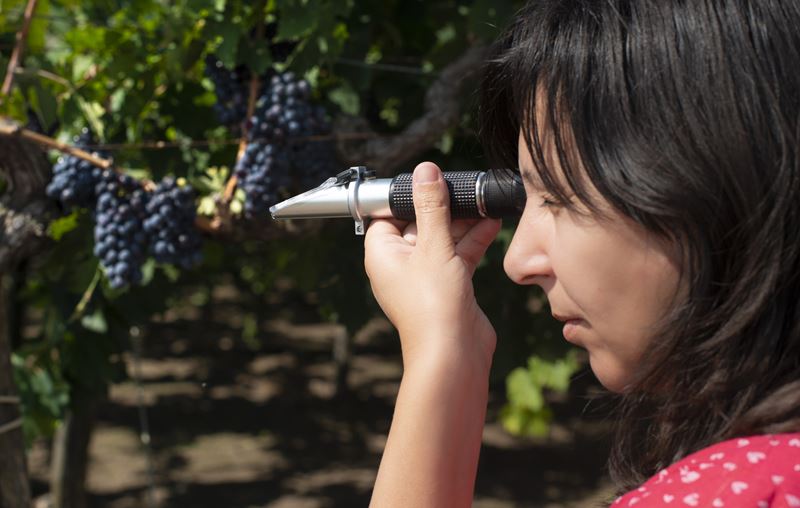What are Brix, Baumé or Oechsle?
Understanding Brix, Baumé, and Oechsle in Winemaking

If you've ever found yourself wandering through the verdant vineyards of a winery, glass in hand, and overheard the winemaker talk about Brix, Baumé, or Oechsle, you might have wondered if they were discussing secret winemaking spells. While they might not be magical incantations, they are indeed crucial to the alchemy of turning grapes into wine. These terms sound like they belong in a science lab, and that's not too far off; they're all about measuring the sweetness of the grape juice, which is a key factor in determining the potential alcohol content of the wine you love to sip on a cozy evening. So, grab your glass, and let's dive into what these terms mean and why they're so important in winemaking.
Brix: The Sweetness Scale
Starting with Brix, named after the 19th-century Austrian scientist Adolf Brix. Brix measures the sugar content in an aqueous solution. When it comes to winemaking, it tells us the percentage of grape sugar present in the juice. One degree Brix is equivalent to 1 gram of sucrose in 100 grams of solution. It's like the winemaker's guide to predicting how boozy the wine can get. The higher the Brix, the higher the potential alcohol content, assuming all the sugar is fermented into alcohol. During harvest, winemakers test the grapes, aiming for a Brix level that will give them the perfect balance of alcohol in the final product. It's a crucial step, because if they get it wrong, the wine could end up too sweet or too strong.
Baumé: The French Touch
Crossing over to France, we find the Baumé scale, developed by French chemist Antoine Baumé. It's another way of measuring the sugar content, but it's calibrated slightly differently to suit the specific needs of French winemaking. The Baumé scale is used primarily in France and countries influenced by French winemaking traditions. Like Brix, a higher Baumé reading means more sugar and thus, more potential alcohol. However, the Baumé scale is a bit trickier to convert directly to sugar content, as it was originally designed to measure the density of various solutions, not just sugar in water. Nonetheless, in the context of winemaking, it serves a similar purpose to Brix, guiding the fermentation process to produce wines with desired alcohol levels.
Oechsle: The German Precision
Heading over to Germany, we encounter the Oechsle scale, which measures the must weight of grape juice, which is a fancy way of saying it measures the grape juice's density compared to water. Named after Ferdinand Oechsle, the scale is pivotal in German winemaking, particularly because Germany produces a wide range of wine styles, from bone-dry to lusciously sweet. The Oechsle scale helps determine the ripeness of the grapes and, therefore, the potential style and quality of the wine. Higher numbers indicate riper grapes with more sugar, which can lead to higher alcohol content or sweeter wines, depending on the winemaking process chosen.
Why Do They Matter?
Understanding Brix, Baumé, and Oechsle is like having a key to the winemaker's diary. These measurements allow winemakers to harvest grapes at just the right time, ensuring the wine has the perfect balance of sweetness, acidity, and alcohol. They're essential tools in the winemaking process, influencing decisions from when to pick the grapes to how the fermentation process is managed. For wine enthusiasts, knowing about these scales adds another layer of appreciation to the art and science of winemaking. It's fascinating to see how a combination of natural elements and human ingenuity, measured in degrees of Brix, Baumé, or Oechsle, can transform simple grapes into the complex and delightful beverage we cherish.
How is sugar measured?
A refractometer is a handheld device that measures the concentration of an aqueous solution by evaluating how light bends, or refracts, as it passes through the liquid. When light enters a liquid from the air, it slows down and changes direction; the amount it slows by depends on the substance's density. Sugar increases the density of grape juice, so by shining a light through a sample, a refractometer can tell us how much sugar is in there. It's like a magic wand for winemakers, providing a quick and easy way to check the ripeness of their grapes.
So, the next time you're enjoying a wine tour or tasting, and you hear mentions of Brix, Baumé, or Oechsle, you'll know exactly what's being discussed. It's not just about the numbers; it's about the journey from vine to wine, guided by these essential measurements. Cheers to that!
Founded in 2007, Vinetur® is a registered trademark of VGSC S.L. with a long history in the wine industry.
VGSC, S.L. with VAT number B70255591 is a spanish company legally registered in the Commercial Register of the city of Santiago de Compostela, with registration number: Bulletin 181, Reference 356049 in Volume 13, Page 107, Section 6, Sheet 45028, Entry 2.
Email: [email protected]
Headquarters and offices located in Vilagarcia de Arousa, Spain.